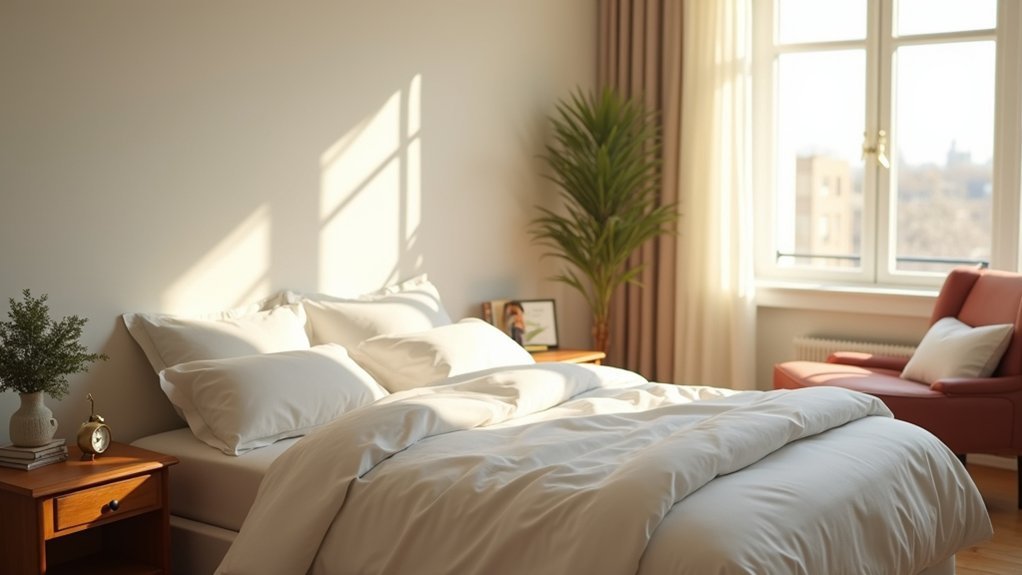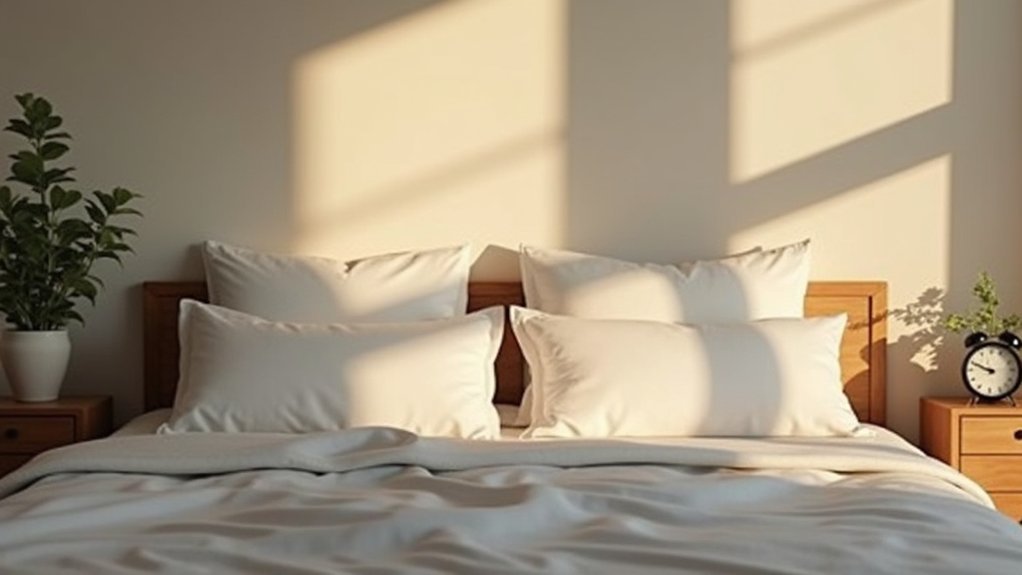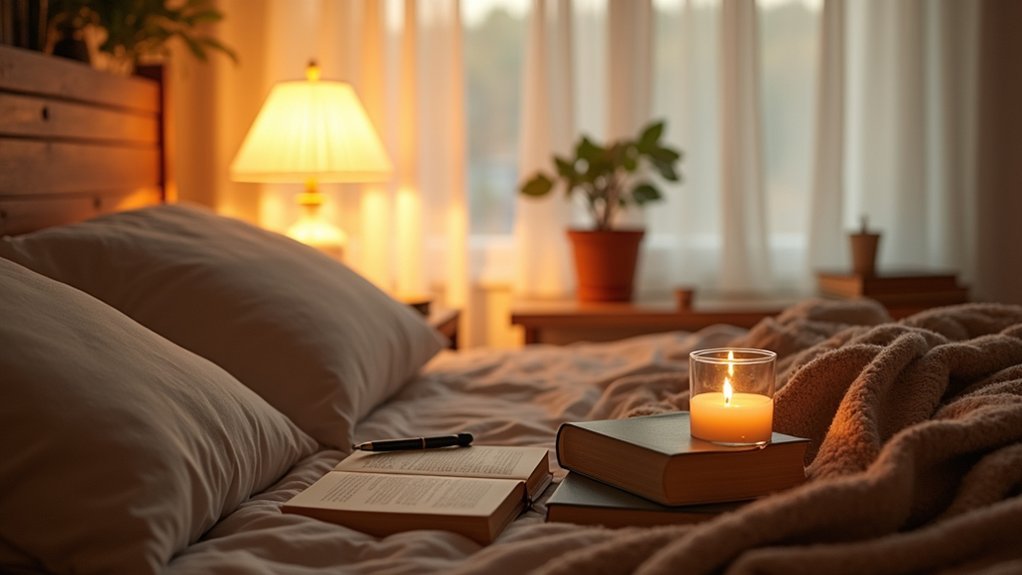Studies show that 72% of adults sleep with their smartphones within arm’s reach, greatly disrupting sleep quality and overall health. Your nightly digital companion might be sabotaging your rest more than you realize. By creating a phone-free bedroom, you’ll not only improve sleep patterns but potentially transform your nighttime routine. Are you ready to reclaim your sleep sanctuary and discover the profound impact of disconnecting? The journey to better rest begins with understanding how your device affects your most vulnerable hours.
Key Takeaways
- Designate a specific charging station outside your bedroom, creating a clear physical boundary between technology and sleep space.
- Install an analog alarm clock to eliminate smartphone dependency and reduce nocturnal digital temptations.
- Establish a pre-sleep digital detox routine by turning off all electronic devices at least one hour before bedtime.
- Transform your bedroom into a relaxation sanctuary with soft lighting, calming textiles, and minimal technological distractions.
- Replace smartphone activities with alternative wind-down practices like reading, meditation, journaling, or listening to soothing music.
Understanding Screen Time and Its Impact

Have you ever wondered why your smartphone feels like an extension of yourself, yet simultaneously drains your mental energy? Screen time has surged 50-70% since 2020, creating significant psychological consequences. Research demonstrates that excessive digital engagement directly correlates with increased anxiety, isolation, and disrupted sleep patterns. When you’re keeping phones near your bedroom, you’re inadvertently compromising your mental wellness and nocturnal restoration.
Scientific evidence reveals that prolonged technology exposure triggers stress responses and heightens self-critical tendencies. Your brain processes digital stimuli intensely, making time without screens essential for psychological reset. The growing trend toward intentional disconnection—exemplified by the rise of “dumbphones” and government policies like Australia’s “Right to Disconnect”—underscores the urgent need to establish healthier digital boundaries, especially in personal sleep environments.
Benefits of a Phone-Free Bedroom

Tranquility emerges when you liberate your bedroom from digital intrusions, transforming this personal space into a sanctuary of restorative potential. By eliminating blue light exposure from devices, you’ll greatly enhance sleep quality and melatonin production. A phone-free bedtime routine allows your body to naturally prepare for rest, reducing stress hormones and minimizing anxiety.
The scientific benefits extend beyond immediate relaxation. You’ll experience improved morning focus, decreased likelihood of insomnia, and enhanced emotional well-being. Better sleep isn’t just about duration, but about creating an environment conducive to deep, uninterrupted rest. Mindful device separation encourages introspection and connection, replacing digital stimulation with genuine self-reflection and mental restoration.
Your bedroom becomes a healing space, optimized for thorough physical and psychological rejuvenation.
Preparing Your Sleep Environment

Transforming your bedroom into a sleep-optimized sanctuary requires strategic environmental design. By removing the phone in your hand and establishing clear spatial boundaries, you’ll create a conducive sleep atmosphere. Place an analog alarm clock on your nightstand to eliminate smartphone dependency and minimize blue light exposure during night hours.
Strategically design your sleep environment by designating a charging station outside the bedroom, ensuring devices remain away from screens during critical rest periods. Soft, dimmed lighting and calming textiles can further enhance relaxation, signaling to your brain that it’s time to wind down. This intentional approach supports your night’s sleep by reducing digital stimulation and creating a tranquil, technology-free zone that promotes natural sleep cycles and improved overall rest quality.
Establishing Nightly Disconnection Strategies

As technology increasingly infiltrates our daily lives, developing robust nightly disconnection strategies becomes critical for preserving sleep quality and mental well-being.
To guarantee a good night’s sleep and help you fall asleep more easily, consider these disconnection strategies:
- Turn off all electronic devices one hour before bedtime to reduce blue light exposure
- Charge your phone in a designated area outside the bedroom
- Use an analog alarm clock instead of your smartphone
- Communicate your phone-free time boundaries to family and friends
- Engage in calming activities like reading or meditation before sleep
Alternative Bedtime Activities

When breaking free from digital distractions, individuals can discover a rich landscape of alternative bedtime activities that scientifically support better sleep hygiene and mental restoration. Reading physical books provides a proven method for falling asleep, reducing screen-induced stimulation while promoting mindfulness and relaxation. Journaling offers emotional processing and stress reduction, allowing your mind to decompress before sleep. Meditation and deep breathing exercises systematically lower anxiety levels, preparing your body for restorative rest. A warm bath signals neurological wind-down mechanisms, further supporting sleep changeover. Listening to gentle music or nature sounds creates a tranquil environment that encourages physiological relaxation. These evidence-based alternative bedtime activities replace electronic interactions, helping you cultivate a peaceful pre-sleep routine that supports thorough mental and physical restoration.
Managing Digital Withdrawal
After exploring alternative bedtime activities, understanding digital withdrawal becomes essential in establishing a phone-free bedroom. Digital withdrawal can notably impact your shift to a screen-free environment. Consider these strategies to manage withdrawal symptoms:
- Recognize withdrawal signs like anxiety and restlessness when reducing screen time
- Gradually decrease phone usage before bedtime to ease shift
- Engage in constructive alternative activities like reading or journaling
- Practice mindfulness to address underlying needs driving phone use
- Track improvements in sleep quality and emotional well-being as motivation
Tracking your progress helps maintain commitment. By understanding digital withdrawal as a natural response to changing habits, you’ll develop resilience. Self-compassion is vital during this adjustment period, allowing you to navigate the challenges of creating a phone-free bedroom with patience and scientific precision.
Tracking Your Progress and Maintaining the Routine
While transforming your bedroom into a phone-free sanctuary requires consistent effort, tracking your progress becomes a critical component of long-term success. Start by maintaining a daily log that documents your time spent away from digital devices and its correlative impact on sleep quality and emotional well-being. Utilize habit-tracking applications or physical calendars to visually mark your phone-free routine achievements, creating tangible evidence of your behavioral modifications.
Conduct weekly self-assessments to evaluate improvements in your sleep patterns and psychological state. Set incremental, realistic goals that gradually reduce screen time and celebrate milestones to reinforce positive behavioral changes. By systematically monitoring your progress, you’ll develop empirical insights into the neurological and physiological benefits of a phone-free bedroom environment, ultimately strengthening your commitment to this transformative practice.
Frequently Asked Questions
How Far Away Should Your Phone Be When Sleeping?
You’ll optimize sleep quality by placing your phone at least 10 feet from your bed, creating a digital detox zone that improves bedroom environment and reduces blue light disruption to your natural sleep cycle.
How Long Should You Be off Your Phone Before Bed?
Hark, digital wanderer! You’ll want to power down your phone at least one hour before bed. This digital detox enhances sleep quality, supports a calming bedtime routine, and minimizes disruptive phone usage that can derail your restorative rest.
How Can I Hide My Phone in My Bedroom?
You’ll effectively hide your phone using creative storage techniques: utilize drawer compartments, disguise it beneath books, or invest in dedicated phone-concealing containers that minimize visual triggers while scientifically supporting better sleep hygiene and reduced digital stimulation.
How Do I Detach Myself From My Phone?
You’ll successfully detach from your phone through a digital detox by establishing mindful usage boundaries, engaging in alternative activities, and fostering sleep hygiene. Strategically replace screen time with intentional, enriching experiences that prioritize your mental and physical well-being.
Conclusion
You’ve transformed your bedroom into a sanctuary of serenity and rest. By banishing digital distractions, you’re reclaiming your sleep health and mental clarity. Embrace this journey of mindful disconnection, knowing each night brings deeper relaxation and rejuvenation. Your phone-free bedroom isn’t just a space—it’s a commitment to your well-being, a demonstration to prioritizing personal tranquility over constant connectivity.

